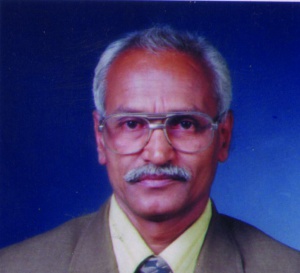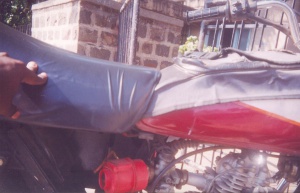Name : Arvind Khandke
District & State : Kolhapur, Maharashtra
Category : Ecofriendly Green/Energy conservation
Award :
Award Function : 3rd National Grassroots Innovation Awards
Award Year : 2005
Innovation Description
 Arvind Janardan Khandke (54), a 9th grade pass hails from Kolhapur, Maharashtra. A cloth merchant by profession, Khandke is an auto enthusiast obsessed with fuel conservation. His hobbies include research work and reading as well as swimming. His aspiration is to pass on something valuable to the next generation. His family comprises his wife, four daughters and a son. His monthly income is Rs. 7000/- per month.
Arvind Janardan Khandke (54), a 9th grade pass hails from Kolhapur, Maharashtra. A cloth merchant by profession, Khandke is an auto enthusiast obsessed with fuel conservation. His hobbies include research work and reading as well as swimming. His aspiration is to pass on something valuable to the next generation. His family comprises his wife, four daughters and a son. His monthly income is Rs. 7000/- per month.
So declares Arvind Khandke, who has developed an eco-friendly non-return valve which reduces CO and hydrocarbon emissions from the inlet side of the engine.
Genesis
Arvind Khandke is a cloth merchant who owns a handloom saree shop in Kolhapur. As part of his business, he used to travel a lot on his Rajdoot motorcycle (manufactured by Escort). While riding the motorcycle he was often troubled by the engine vibration and the high fuel consumption. This forced him to think of developing a device which would overcome the above problems.
While studying the process, one day in 1980 he found that the air filter was oily and he inferred that there was some loss as the air fuel mixture from the cylinder rebounds and was escaping from the carburetor. To stop that wastage, he decided, to fit a valve type device. Thus in 1983, he designed the first prototype of the valve out of mild steel. But during the trials he found that the flap of the valve was too heavy to work effectively. He changed the material of the flap and designed a new valve using nylon and Poly Propylene to suit 1 HP to 1.25HP engines.
He filed for a patent application in 1994 which was awarded to him in 1999. Some of the problems he faced while developing this innovation were the lack of proper co-operation by experts in the field and non-availability of the laboratory/equipments for the testing of the products. While developing this innovation he recalls that he was not able to concentrate on his business and family life and this single minded devotion has had an adverse effect on his financial position. He took about 12 years to develop the solution
Video | This innovation is an attachment for a four-stroke as well as two-stroke petrol engine which aims to accomplish economy in fuel and reduction in emissions.
The non return valve is fitted between the air filter and the carburetor in petrol engine and between the air filter and intake manifold in a diesel engine. It comprises main body having a hollow cavity within and an extended hollow neck at the end for connecting the same over the hose pipe of the carburetor. The valve is essentially a mechanism to ensure fuller combustion of the air-fuel mixture in the combustion chamber and reduces the release of un-burnt fuel. Such un-burnt fuel also causes pollution apart from reduction in fuel efficiency.
In existing engine designs, to take advantage of the inertia effect, the inlet valve remains open at about 400 when the piston reaches Bottom Dead Center (BDC) at the start of the compression stroke (at the end of suction stroke). At this time charge pressure is less than the compression pressure. So during this period, some of the charge escapes through the inlet valve, after hitting on the cylinder wall and the piston top through the carburetor and air filter. This cycle continues for every suction stroke of the engine. This leads to improper combustion due to inappropriate proportion of air and petrol. Due to this cycle the volumetric efficiency of the engine reduces and hence loss of power takes place. Khandke referred to these effects as “Bounce Back Loss”. This loss increases with increase in speed because as the speed increases the valve opening time during compression stroke also increases. In addition, the air filter of the petrol engine tends to get clogged by the oil particles which catch and hold dust particles rendering the air filter element ineffective more quickly than otherwise. The filtering element in the air filter assembly is also expected to remain dry, but this is not the case. To solve this problem, some attempts were made to provide reed valve or rotary valve, the construction of which is quite complicated and hence it was not found suitable. But Khandke’s Non Return Valve captures these losses by not allowing the return of the charge towards the carburetor or the air filter side of the petrol engine and thus increases the overall engine efficiency. The valve has to be replaced after 25,000 km and costs Rs.1000.
Current status
In 1994 he was granted a patent for the use of this device in two- stroke engines. He then filed a patent application for the use of the device on 4 stroke petrol engines. Since 1996 to 1998 trials were conducted in the D. Y. Patil College of Engineering and based on the results some more modifications were done in the valve in 1999 and 2000. In 2001 he got the patent for four stroke engines. The device was tested on Premier Padmini, auto rickshaws and motorbikes. Only he has been using it since1982. Since 1980 he has been investing his own funds to develop this innovation. This device has potential to apply to all automobiles (2 strokes/ 4 stroke engines). This has also been tested on Three Wheeler auto Rickshaw and they have also got 25 to 30% gain by using it. The innovation was also featured in an article in the December 1997 issue of Indian Auto. Arvindbhai got the first prize in the Innovation Fair at Avenues, 2004 the Technology Festival of IIT, Mumbai.
Extensive tests and trials…
To prove the bounce back effect and its losses initially different trials were conducted on different types of vehicles. These tests were conducted without valve and with valve connected. These tests were conducted in the laboratory and on the roads also.
Initially the tests were conducted with Auto Rickshaws at M/S Ghatge Patil Automobiles, a leading automobile dealer in Kolhapur in 1984. The certificate from Ghatage Patil Automobiles shows that there is 18.69% improvement in petrol consumption.
Tests were conducted in the lab of D.Y Patil Engineering College on a cylinder in line engine, such as Premier Padmini, on the test bed. From the tests, it was observed that under a certain speed range, the results were favorable when the valve was connected to the carburetor i.e. the result showed saving in fuel consumption over this speed range. The saving in fuel consumption resulted due to the turbulence of the incoming mixture and increase in volume-efficiency due to prevention of bounce back losses to a considerable degree.
On road petrol consumption
As per testing on the premier Padmini car on the road, the average/mileage was found to be 10 km with out valve and 13 km with valve attached. This shows fuel savings of 30 %. Tests were conducted for Carbon Monoxide & Hydro Carbon emissions on Enfield (350c.c) with and without valve at the Government Polytechnic at Kolhapur in 1999. At 120 rpm the % of CO reduction with valve is 8.3% while that at 2000 rpm is 19%. Also HC % reduction at 120 rpm is 28% while at 2000 rpm it is 82%. As speed rises the turbulence rises and with the valve and combustion is effective and losses are minimal as compared to without valve condition.
To get the visual effect of the bounce back losses, the test was conducted on a Kawasaki Bajaj Boxer single cylinder 100c.c engine in “Kaushal Auto clinic” Kolhapur and recorded on CD with the help of video camera.
Tests were also carried out on a Bajaj – Boxer (4 stroke engine of a two wheeler) at the PUC test centre of Associated Petroleum Corporation, C.G.Road, Ahmedabad in 2004 and the results turned out satisfactory.
All the above results show that this valve improves engine efficiency leading to better petrol consumption (fuel saving) and reducing pollution levels. Hence one should be able to minimize the green house effect to some extent by using this valve. However the results have not always been consistent and a need was felt for some improvement.
Applications in current scenario…
Currently the two and four wheeler market is growing rapidly in India and air pollution has become a major issue. As per present technology, it is considered that air pollution by vehicles is because of the emission from the exhaust, but Khandke has proved that the bounce back losses from the side of the carburetor also contribute in polluting the air. Scientists have been trying to reduce the pollution from the exhaust side (as per euro 1, euro 2 Norms) but they have not been thinking of incomplete combustion as a reason and at present there is no competitive technology innovation in practice. Hence this eco-friendly valve developed by Khandke assumes all the more importance as it looks towards a pollution free environment.
http://nif.org.in/innovation/Eco-friendly_Non-return_valve_for_Two-Wheeler_Engines/233
